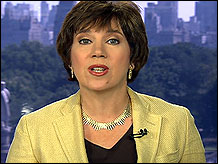|
|

|
| CNN's Kathleen Hays reports on the economic impact of surging fuel prices, corporations pledging help to hurricane victims and more. (September 1) |
Play video
|
|
|
|
|
|
NEW YORK (CNN/Money) -
Greenspan's up to bat expecting a long, slow lob across the plate as he plays the final game of his career and dreams of coming retirement, when suddenly Hurricane Katrina throws him a curve ball: the Southeast is in shambles, the entire country at the mercy of punishing gas price spike.
What does the Fed do now? Swing for the bleachers and keep hiking rates ... or let the pitcher walk him and take a pause at this month's meeting?
Perhaps there was a big clue in the Kansas City Fed conference in Jackson Hole Wyoming one week ago, where Alan Greenspan defined the heart and soul of the monetary policy regime he has guided and ruled over for the past 18 years as (ta da! ...) "Risk Management."
No single-variable model like a given inflation rate for Mr. G. No formal model that inevitably fails to capture the complexities of a dynamic, evolving economy. "Given our inevitably incomplete knowledge about key structural aspects of an ever-changing economy... the paradigm on which we have settled has come to involve, at its core, crucial elements of risk management," he said.
Risk management! Think the stock market crash of 1987, the Asian currency crisis of 1997 that gave way to the Russian bank meltdown of 1998, the 9/11 attacks that pushed a tottering economy to its knees. The Greenspan Fed cut rates quickly, and to paraphrase a colleague, Steve Beckner, pulled the economy back from the brink.
It's instructive that Greenspan himself in his Jackson Hole speech used the deflation scare of 2003 to explain how this policy of risk management works. The inflation rate was ebbing, the economy was floundering and the Fed cut rates. Greenspan said the Fed thought the risk of such a deflation was small, "the implications for the economy were so dire that should that scenario play out we chose to counter it with unusually low rates."
In other words, compared with the risk that the Fed might cut rates too much and cause some inflation, the risk that it might let deflation take hold was a far, far greater danger that would hurt the economy much, much more. It's the mini-max theory of central banking: minimize the risk of making the mistake that would inflict maximum damage.
So where is the Fed now? It has been on a very different path since last June, hiking rates at meeting after meeting by the same modest amount and signaling that more of the same lies ahead. First to reverse a move that might be too "stimulative" and more and more lately to make sure that inflation does not get out of control.
But now, when the Greenspan Fed least expects it, a new and potentially deadly scenario. A hurricane that devastates one of the most important oil producing and refining regions of the country, that cripples shipping along one of the nation's most important waterways, that destroys homes, crops and businesses across a broad swath of the country. Gas prices spiking, long lines forming, and politicians across the land warning the station owners not to "gouge" their customers.
So, Mr. Greenspan, when you apply the yardstick of risk management to the situation at hand, where do you come down?
With all this uncertainty hanging over the economy from the hurricane, with a well-known history of oil and gas spikes helping to cause every recession in the United states since 1960, do you continue to hike rates to fight inflation? Or do you decide at the very least to pause along your rate-hiking path ... to say that the devastation in the Gulf combined with a nationwide energy price spike represent a potential economic crisis that the Fed cannot afford to ignore?
On one side there are those calling for the Fed to "stay the course;" and keep hiking rates saying this is no time "to go soft." On the other, there are those saying that its next move may very well be to cut rates down a notch. In the middle stands Mr. Greenspan, with the power to hit one more home run for the economy and for the markets. But he knows that his last play will be remembered as an error if he doesn't get it right.
______________________________
Kathleen Hays is economics correspondent for CNN. You can read more of her columns here.

|